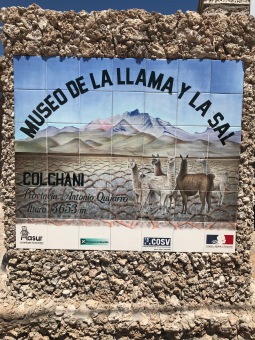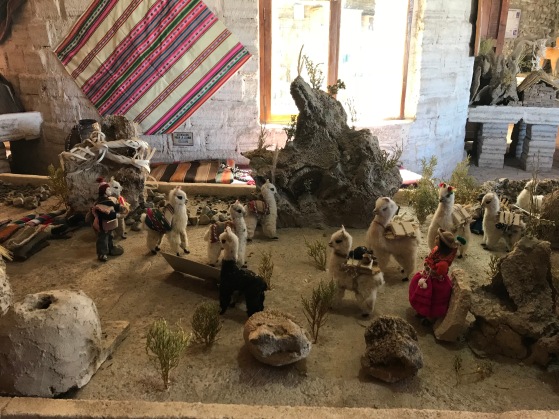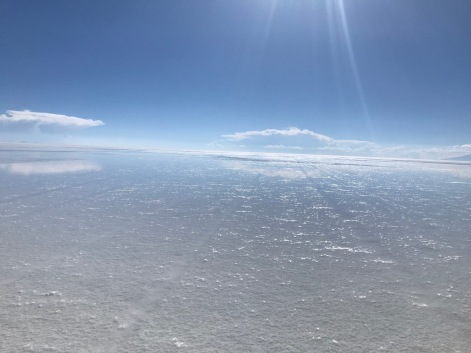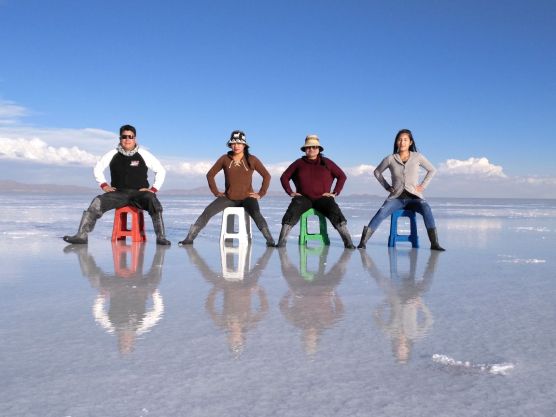Even though I am here for school purposes, my practicum program gives us time to explore La Paz and Bolivia. I spent this past weekend in Uyuni, Bolovia, home to the world’s largest (and highest) salt flat!
I know, I know…visiting a salt flat sounds boring and/or lame, but it was actually quite beautiful. My tour started with a drive past fields of red quinoa plants. According to Bolivians, the best quinoa in the world comes from these fields, as the minerals in the soil create a very nutritious and uniquely tasty grain.

Next stop was the train cemetery in Colchani. The train tracks that run through here are the original tracks that carried silver and other minerals from Potosí to the coast for sale and distribution. Since Bolivia no longer has a sea port, these tracks now lead to Chile.
I have no idea why a place where trains go to die is a tourist attraction, but it was kind of cool to explore train cars up close. Lots of tourists climb the cars. I might be current on my tetanus shot, but I wasn’t willing to push my luck.
After visiting the train cemetery, we visited the small town of Colchani. There is a small museum here that is supposed to be about the salt mining and manufacturing process, but it mainly focused on llamas. I can’t say I learned anything at this museum, but it did have some very entertaining miniatures.




Colchani also has a row of stalls selling various handicrafts and items made from salt. It took every single bit of self control I had not to buy one of these stuffed llamas/alpacas. IT’S SO FLUFFY I COULD DIE!

After leaving Colchani, we headed straight for the salt flats. I’ll let Wikipedia provide us all with some basic info: “the Salar de Uyuni is the world’s largest salt flat at 10,582 square kilometers (4,086 sq mi). It is at an elevation of 3,656 meters (11,995 ft) above sea level. The Salar was formed as a result of transformations between several prehistoric lakes. It is covered by a few meters of salt crust, which has an extraordinary flatness with the average elevation variations within one meter over the entire area of the Salar. The crust serves as a source of salt and covers a pool of brine, which is exceptionally rich in lithium. It contains 50% to 70% of the world’s known lithium reserves, which is in the process of being extracted. The large area, clear skies, and exceptional flatness of the surface make the Salar an ideal object for calibrating the altimeters of Earth observation satellites.”
It is currently the rainy season in Bolivia, so the Salar is covered in rainwater. When I visited, the water was 4-6 inches high in some places.



In other places, the salt is wet, but not saturated. In these areas, you can see the many colors that lie under the salt crust.
And because science is cool, here are photos demonstrating how the water effects the shape of the salt crystals. The photo on the left shows the salt crystals from the drier parts of the Salar. The photo on the right shows the salt crystals from the parts of the Salar that are underwater. Travel tip – if you visit the Salar, I would not recommend walking across it without shoes. These crystals (particularly those that are underwater) are quite sharp.
The Tunupa volcano provides enough heat to create bubbling pools throughout the Salar. These pools are similar to the geothermal pools you’d see at Yellowstone or in Iceland, except the bubbling water is very cold!

The combination of water and calm winds creates a mirror effect. Unfortunately, the winds were pretty strong the day I visited, so I couldn’t get good pictures of the reflection of the sky upon the water. But that didn’t stop my tour group from taking all sorts of silly pictures to capture what we could of this mirror effect.
The vastness and flatness of the Salar allow you play around with proportions:
And for the tour’s final act, I got eaten by a TRex:


























Salt flats are interesting and have their own kind of beauty. Who knew? Great blog post! Love the T-Rex.
LikeLiked by 1 person
Looks like some wonderful photography opportunities. The world sure is beautiful!
LikeLiked by 1 person
These salt flats are eight wonders of the world. Beautiful pictures. I did not know that dinosaur still roams the salt flats😂. It looks like a fun place to rest and relax.
LikeLiked by 1 person
I must say that Your blog is Exceedingly well written. Your words paint a beautiful picture where reader can experience all that you are describing. Thank you!
LikeLiked by 1 person